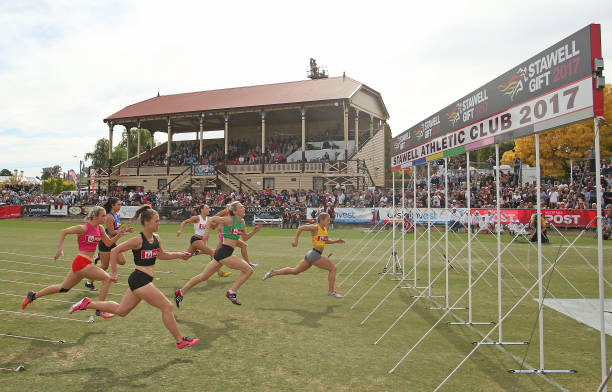26 Aug 2021

(Photo by Darrian Traynor/Getty Images)
The Gift of vaccination is being Stawelled and although it isn’t a race, Australia is coming last. No one seems to be in a hurry, and those whose turn it is to run are confronted with so many different lanes that it is quite confusing.
The basic problem is the imbalance between demand and supply. ‘The market’ has proved to be imperfect again. Demand is being limited by regulation about whose turn it is – by population group, calendar dates and choice of vaccine.
My wife was accommodated by her GP. My GP seems not to have been favoured so I tried the local field hospital – recalling some of my previous trips to the place when it was a cricket pitch. But it was the wrong day or the wrong brand and all I came away with was the phone number to call.
The hold music was not too bad at first but after an hour I accepted The Voice’s offer to leave my mobile number and it would get back to me.
I don’t always carry my phone with me unless I’m photographing Nature; so a few days passed.

Having tried the leave-my-number routine a couple more times, I thought surely I could be provided with the necessary material if I attended in person. Upon arrival at the correct hospital I was the fourth person around. One of the other three was keeping guard and however hard I tried I couldn’t get more than the phone number. No appointment, no access, no worries. Very firm. (Someone who only has one job can really concentrate.)
At the hospital’s main entry I had better luck. I quickly had a small sticky label and very soon thereafter a lollipop.
One might think that a large and diverse system would be a good thing, given the number of people to be serviced. In fact I think people have been uncertain about how to get the job done and the queuing and appointments system has been slow and clunky.
In a previous piece I suggested that a one-off boost to the number of people who have had the jab could be given by offering all those who, like me, had the first AstraZeneca some time ago the option of bringing forward the second one. Granted there is uncertainty about the extent to which this would affect, week by week, the efficacy of the vaccine.
Governments have been slow to realise the value of localised, targeted, culturally appropriate options for vaccine delivery. So many commentators on media have argued that the main barrier or disincentive is the lack of convenience in getting it done.
Perhaps because the processes in train have not been under any single agency’s control, active management of the program has been missing. Things have just drifted.
Initiatives such as pop-up and drive-through vaccination clinics, local support for local rollout to specific cultural groups, and a flying-squad type approach to communities facing special risks were slow to emerge, despite the demonstrated success of such activities in other countries. The U.K.’s first drive-through vaccinations were given in December.

The most serious result of the underperforming program has been the failure to meet the earliest targets, such as protecting through inoculation the staff and patients of residential health, aged and disability care facilities. One of the results of this failure has been the loss of capacity, especially in hospitals, when staff members have had to be isolated.
The case of aged care workers
At the outset the task looked like one that would provide many political benefits, given the generally positive view of vaccination. It was therefore no surprise when the Prime Minister said that responsibility for the vaccination program was the Commonwealth’s. There was the usual caveat that its management would be in collaboration with the States and Territories.
So arguably the uncertainty began early, with the potential for overlap and task shifting between Federal and State departments. The program grew like Topsy.
Consider, for example, the case of workers in aged care.
The Commonwealth contracted commercial entities to deliver vaccinations to the 2566 Commonwealth-subsidised residential aged care facilities for residents and, where additional vaccines were available, workers. (Giving staff doses that were left over at the end of a clinic for residents must have given a negative message?)
Staff of aged care facilities could also attend a GP’s rooms, or a State clinic (in a public hospital), or one of the specially established state vaccination hubs.
But Primary Health Networks (PHNs) were nominated as the primary point of contact for residential aged care facilities on vaccination for residents and workers, and were allocated Pfizer doses for this purpose. The PHNs liaised with the contracted providers, which could provide in reach, mobile and hub models for residential aged care workers and residents.
Workers from residential aged care facilities located in the same PHN as disability vaccination hubs could access a Pfizer vaccine at these hubs.

A forward schedule of dedicated Covid-19 vaccination clinics was available to aged care provider peaks and unions to provide local information on upcoming clinics to residential aged care workers.
From August selected pharmacies have been providing Pfizer vaccines.
Convenience has been a major issue. For many people, getting the vaccination involves the loss of a shift, loss of wages, logistical issues with access, or finding information in an appropriate language.
The menu was extensive but many who consulted it found its fair and its language to be quite alien.
Alternative means
Some people believe the Commonwealth should not manage new, large-scale programs because of a poor track record in such things. The alternative view is that no agency is in a better position than the Commonwealth to oversee a program which requires uniform eligibility checks and national data and tracking.
The experience to date from covid-19 suggests that what is required is national leadership and record-keeping, with the actual rollout being undertaken by a limited number of agency types. State and Territory arrangements should allow for local providers to work in settings and with population groups who require the deliverers to have special skills. For example, delivery to those who do not have English as a first language should involve people with whom they are familiar and language they know well.
This principle should be applied whenever possible to meet the special requirements of people who are disadvantaged in economic, social and cultural terms.
In setting up the program for covid consideration was presumably given to scaling up the National Immigration Program (NIP) which has a good reputation as a provider of a range of vaccinations over a person’s lifetime. It would be valuable to understand why such a model was not developed.
Workplace vaccination against flu has also been successful in many instances and must also have provided lessons for covid.

For as long as vaccine remains in short supply relative to demand, setting priorities for its use will remain critical. The priority order for allocation of a scarce resource that saves lives is something that should be openly discussed and understood. To date little evidence on the matter has been publically available.
With greater understanding of the importance of vaccination and how decisions relating to it are made, people are likely to be more invested in the campaign and thus more willing to comply with and support it.
Note: this is the first of three posts that have been delayed as I tried unsuccessfully to have them published elsewhere.
